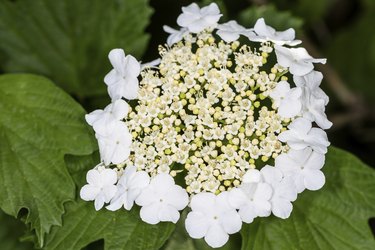
Viburnums (Viburnum spp.) are among the most diverse plant families. The more than 150 species include hundreds of cultivars, and range from low-growing shrubs to towering, tree-sized plants. Versatile viburnums grow best in full sun or part shade and in rich but well-drained soil, but are hardy enough to adapt to less ideal conditions. Many viburnums are deciduous, while others are evergreen. Plants in the latter group make the best hedges. In general, viburnums should be spaced between 4 and 10 feet apart, but this varies depending on the plant's maximum width at maturity.
Sweet Viburnum
Video of the Day
Step 1: Choose a Sunny Spot for Your Viburnum Hedge
Locate your sweet viburnum (Viburnum odoratissimum) hedge in full sunlight. These large shrubs like warm conditions and are hardy in USDA zones 8 through 10.
Video of the Day
Step 2: Pick a Moderately Moist Location
Select a spot that features moderate to moist, but not dry or waterlogged, soil to stimulate strong root growth.
Step 3: Measure and Mark
Measure the length you want the hedge to be, and mark off 5-foot sections.
Step 4: Plant the Sweet Viburnum Plants 5 Feet Apart
Plant sweet viburnum shrubs 5 feet from each other, as measured from center to center, to form a thick hedge. If you are going to let the shrubs grow to their maximum size, space them 6 or 7 feet apart.
Laurustinus Viburnum
Step 1: Select a Sunny or Partially Sunny Location
Give Laurustinus viburnum (Viburnum tinus) full sun or part shade. These medium-sized shrubs can tolerate a bit more shade and cold than sweet viburnum, and are hardy in USDA zones 7b through 10.
Step 2: Choose a Moist Spot
Locate the hedge in moist but well-drained soil.
Step 3: Measure and Mark
Measure the length of the hedge and mark a line off in 6-foot intervals.
Step 4: Space Your Shrubs 6 Feet Apart
Space Laurustinus viburnum shrubs 6 feet apart as measured from center to center.
'All That Glitters' Viburnum
Step 1: Choose a Sunny or Partially Sunny Location
Plant 'All That Glitters' viburnum (Viburnum bracteatum "SMVDLS") in full sunlight or partial shade. This small and compact viburnum is cold hardier than most, and thrives in USDA zones 5 through 8. Its leaves shimmer in the sunlight, hence its common name.
Step 2: Select a Spot With Good Drainage
Select soil that is average but well-drained -- this hardy plant will also tolerate clay soil and urban conditions.
Step 3: Measure and Mark
Measure the length of the hedge, and mark off 5-foot intervals.
Step 4: Space 'All That Glitters' Shrubs 5 Feet Apart
Space 'All That Glitters' viburnum shrubs 5 feet apart as measured from the center of each shrub.
Tip
For other viburnum species, determine the average maximum mature width of your plants by looking at the tag or asking an expert at your local garden or university extension center. In general, most hedge plants, including viburnums, should be spaced apart by about half of their maximum mature width -- or even a little less than that, if you want a dense hedge -- as measured from the center of each bush.
Viburnums are best planted in fall and can be pruned to control for size and to shape.
To create an extra-thick hedge, plant two rows that are 12 inches apart, staggering the plants.